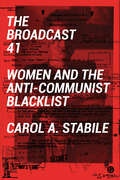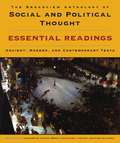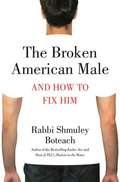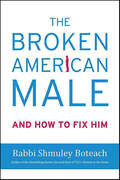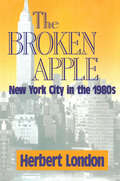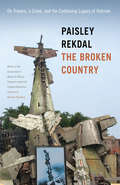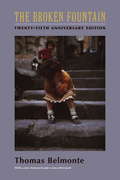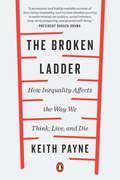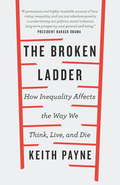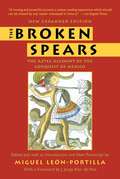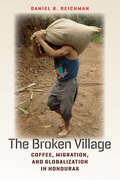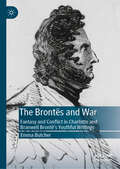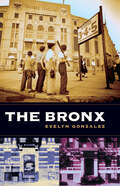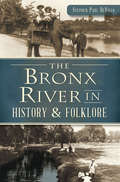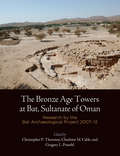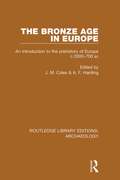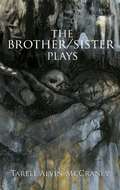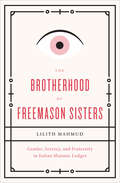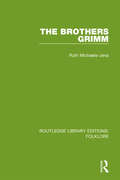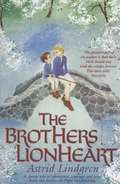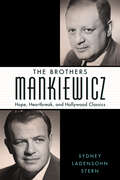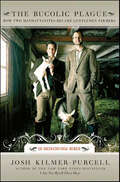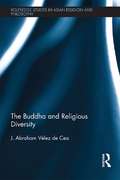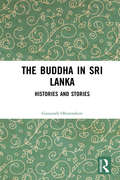- Table View
- List View
The Broadcast 41: Women and the Anti-Communist Blacklist (Goldsmiths Press Ser.)
by Carol A StabileHow forty-one women—including Dorothy Parker, Gypsy Rose Lee, and Lena Horne—were forced out of American television and radio in the 1950s “Red Scare.”At the dawn of the Cold War era, forty-one women working in American radio and television were placed on a media blacklist and forced from their industry. The ostensible reason: so-called Communist influence. But in truth these women—among them Dorothy Parker, Lena Horne, and Gypsy Rose Lee—were, by nature of their diversity and ambition, a threat to the traditional portrayal of the American family on the airwaves. This book from Goldsmiths Press describes what American radio and television lost when these women were blacklisted, documenting their aspirations and achievements.Through original archival research and access to FBI blacklist documents, The Broadcast 41 details the blacklisted women's attempts in the 1930s and 1940s to depict America as diverse, complicated, and inclusive. The book tells a story about what happens when non-male, non-white perspectives are excluded from media industries, and it imagines what the new medium of television might have looked like had dissenting viewpoints not been eliminated at such a formative moment. The all-white, male-dominated Leave it to Beaver America about which conservative politicians wax nostalgic existed largely because of the forcible silencing of these forty-one women and others like them. For anyone concerned with the ways in which our cultural narrative is constructed, this book offers an urgent reminder of the myths we perpetuate when a select few dominate the airwaves.
The Broadcast Journalism Handbook
by Gary Hudson Sarah RowlandsThis exciting and comprehensive text takes students, trainees and professionals into the world of the modern-day newsroom, covering both key techniques and theory in detail. The second edition has been revised and updated to include all the technical, regulatory and theoretical advances in recent broadcast custom and practice and is influenced by newsrooms around the country. Main features: Complete coverage of all the key skills: news gathering, interviewing, writing and story-telling, live/location-reporting, online, editing, graphics and presentation. Expert advice and contributions from leading broadcast journalists from the BBC, ITV and Sky News. The Essential Guide, a section on how to get a job, the law and an up-to-date glossary of broadcasting terms. Workshops and Exercises, which provides the opportunity to practise key skills. Case Study, A Closer Look and Thinkpiece boxes help put the theory into context. Remember and Tip boxes summarise key concepts and offer guidance. A DVD demonstrating filming techniques and editing ideas. New for the second edition: Greater emphasis on online elements of broadcast journalism and the role of social media in news gathering. A focus on the interactive nature of the contemporary news process - how to find user-generated content, empower audiences and engage listeners and viewers. The key skills required for students taking the new NCTJ Broadcast Journalism exams. Ideal for students on journalism courses at all levels, this text is also useful for professionals and trainees working in broadcast, print and other media, and those looking at broadcast journalism in the wider context of media studies.
The Broadview Anthology of Social and Political Thought: Essential Readings: Ancient, Modern, and Contemporary Texts
by Andrew Bailey Will Kymlicka Clark Wolf Alex Sager Samantha Brennan Jacob LevyThis volume features a careful selection of major works in political and social philosophy from ancient times through to the present. Every reading has been painstakingly annotated, and each figure is given a substantial introduction highlighting his or her major contribution to the tradition. The anthology offers both depth and breadth in its selection of material by central figures, while also representing other currents of political thought. Thirty-two authors are represented, including fourteen from the 20th century. The editors have made every effort to include translations that are both readable and reliable. In order to ensure the highest standards of accuracy and accessibility, the editors have consulted dozens of leading academics during the course of the volume’s development (many of whom have contributed introductory material as well as advice). The result is an anthology with unparalleled pedagogical benefits; The Broadview Anthology of Social and Political Thought sets the new standard for social and political philosophy instruction.
The Broken American Male: And How to Fix Him
by Shmuley BoteachWhy do American husbands come home from work too exhausted to interact with their families? When did a healthy quest for prosperity become a twisted game no one can win? How did Black Berries and internet porn become more interesting to men than their flesh-and-blood spouses? Shmuley Boteach has made a great study of how families live today-both in his work as a rabbi privately and as host of TLC's 'Shalom in the Home'. He's discovered a disturbing common thread in the families he meets: men responding to the pressure of competition in their work lives by turning away from their loved ones. In a world that judges men by the size of their paychecks and the wattage of their fame, it's all too easy to lose sight of what is truly valuable in life. Men who consider themselves failures and don't love themselves turn into stressed-out dads, distracted husbands and miserable human beings. For these men, alcohol, the internet and sporting events serve as numbing stand-ins for read life. In THE BROKEN AMERICAN MALE, Boteach doesn't just outline the problems facing marriages and nuclear families. He also offers practical, inspiring solutions, showing how wives can reach out to their husbands, helping them become heroes again to their own families.
The Broken American Male: And How to Fix Him
by Shmuley BoteachA noted relationship counselor explores the twenty-first–century problems driving men and their families apart, offering guidance to restore their lives and love.Why do American husbands come home from work too exhausted to interact with their families? When did a healthy quest for prosperity become a twisted game no one can win? How did smartphones and internet porn become more interesting to men than their flesh-and-blood spouses?Shmuley Boteach has made a great study of how families live today—both in his work as a rabbi privately and as host of TLC's Shalom in the Home. He's discovered a disturbing common thread in the families he meets: men responding to the pressure of competition in their work lives by turning away from their loved ones. In a world that judges men by the size of their paychecks and the wattage of their fame, it's all too easy to lose sight of what is truly valuable in life. Men who consider themselves failures and don't love themselves turn into stressed-out dads, distracted husbands and miserable human beings. For these men, alcohol, the internet and sporting events serve as numbing stand-ins for real life.In The Broken American Male, Boteach doesn't just outline the problems facing marriages and nuclear families. He also offers practical, inspiring solutions, showing how wives can reach out to their husbands, helping them become heroes again to their own families.“A vital and fascinating repair manual.” —A.J. Jacobs, author of The Year of Living Constitutionally“A refreshing kick in the teeth.” —USA Today“Boteach's lessons are applicable to anyone hoping to understand and overcome feelings of failure in themselves or their loved ones.” —Publishers Weekly
The Broken Apple: New York City in the 1980's
by Herbert I. LondonOn the brink of bankruptcy in the 1970s, New York City has been restored as a center of economic and cultural vitality in the 1980s. But it has also become an increasingly brutal place, where incivility reigns, drugs lace the streets, and crime is so pervasive that most New Yorkers now consider it a permanent fixture, like gray skies and impossible traffic. What is it that continues to draw people to this city of contradictions?Born and educated in New York, Herbert London knows this city of dreams as few do. The Broken Apple is based on his keen observations of New York's social, political, and cultural life over the critical decade of the 1980s. London examines the city's continuing failures, including a city administration unable to meet the most basic citizen needs or to assure safety and security. He sees schools that have become mean-spirited, with teachers unable to teach, administrators unable to maintain order, and students unable to learn. He describes the new slaves of New York as those in search of a place to live, in a city where housing is in shorter supply than in any other major city in the nation. London asks why, despite all this, everything is bigger than life in New York, and finds the answer in New York's role as the nation's communications hub and the measuring rod by which other cities are judged.London writes with knowledgeable affection about this very special place, where the mundane is freely converted into the metaphorical. His book is an excursion, a guide to what is good, what is bad, and what is awful in the city. It is a montage of the years of Mayor Koch, the period many have described as the city's fin de siecle. But it is also a perscriptive book, pointing out what can be done in practical ways to improve life.The Broken Apple will be of interest to urban specialists as well as those for whom New York is an aspiration or a reality. Like the city itself, the book has something for everyone, from visions of political corruption to acts of redemption. Above all, it captures the pulsating rhythm of this unique city
The Broken Country: On Trauma, a Crime, and the Continuing Legacy of Vietnam (Association of Writers and Writing Programs Award for Creative Nonfiction Series #30)
by Paisley RekdalAn attack in a grocery store parking lot launches an examination of the Vietnam War&’s dark legacy—by the author of The Night My Mother Met Bruce Lee.The Broken Country uses a violent incident that took place in Salt Lake City, Utah, in 2012 as a springboard for examining the long-term cultural and psychological effects of the Vietnam War. To make sense of the shocking and baffling incident—in which a young homeless man born in Vietnam stabbed a number of white men purportedly in retribution for the war—Paisley Rekdal draws on a remarkable range of material and fashions it into a compelling account of the dislocations suffered by the Vietnamese and also by American-born veterans over the past decades. She interweaves a narrative about the crime with information collected in interviews, historical examination of the arrival of Vietnamese immigrants in the 1970s, a critique of portrayals of Vietnam in American popular culture, and discussions of the psychological consequences of trauma. This work allows us to better understand transgenerational and cultural trauma and advances our still complicated struggle to comprehend the war. &“A moving and often gripping meditation on the fallout of war, from violence and racism to melancholy and trauma.&”—Viet Thanh Nguyen, Pulitzer Prize–winning author of The Refugees &“Assembling a remarkable range of materials and testimonies, she shows us both the persistence of war&’s trauma and how we might more ethically imagine those it harms.&”—Beth Loffreda, author of Losing Matt Shepard: Life and Politics in the Aftermath of Anti-Gay Murder &“A compact, thoughtful debut addressing violence, immigrant identity, and the long shadow of the Vietnam War…. A poignant, relevant synthesis of cultural studies and true-crime drama.—Kirkus Reviews
The Broken Fountain
by Thomas BelmonteAs Ida Susser writes in reference to Belmonte's Broken Fountain, "good ethnographies have long lives." This classic of urban anthropology, one of the most acclaimed ethnographies of recent years, offers vivid, literary descriptions of Fontana del Re, an impoverished Neapolitan neighborhood. Belmonte documents the struggles of Neapolitans surrounded by crumbling buildings and economic insecurity. He details family dynamics as well as the working of Naples's informal economy, the day-to-day struggle for economic subsistence, and the intermittent begging and thieving of the young. Taking us from the bustling, vibrant, and gritty streets and alleyways of Naples to the kitchen tables of poor Neapolitan homes, Belmonte resists simplistic depictions of the poor. Instead, he presents subtle, compelling portraits and analyses that capture the emotional, social, and economic lives of his subjects.In addition to the continuing relevance of his insights into the effects of poverty, Belmonte's willingness to reflect on his own reactions and emotions while in the field has influenced a generation of scholars. In The Broken Fountain, he poignantly describes the experience of living alone in a strange urban environment and his interactions with the residents of Fontana del Re.This edition includes a foreword by Ida Susser and an afterword by Pellegrino D'Acierno and Stanislao G. Pugliese.
The Broken Ladder: How Inequality Affects the Way We Think, Live, and Die
by Keith PayneA timely examination by a leading scientist of the physical, psychological, and moral effects of inequality. Today’s inequality is on a scale that none of us has seen in our lifetimes, yet this disparity between rich and poor has ramifications that extend far beyond mere financial means. In The Broken Ladder psychologist Keith Payne examines how inequality divides us not just economically, but has profound consequences for how we think, how our cardiovascular systems respond to stress, how our immune systems function, and how we view moral ideas like justice and fairness. Experiments in psychology, neuroscience, and behavioral economics have not only revealed important new insights on how inequality changes people in predictable ways, but have provided a corrective to our flawed way of viewing poverty as the result of individual character failings. Among modern, developed societies, economic inequality is not primarily about money, but rather about relative status: where we stand in relation to other people. Regardless of their average income, countries or states with greater levels of income inequality have much higher rates of all the social problems we associate with poverty, including lower average life expectancies, serious health issues, mental illness, and crime. The Broken Ladder explores such issues as why women in poor societies often have more children, and have them younger; why there is little trust among the working class that investing for the future will pay off; why people’s perception of their relative social status affects their political beliefs, and why growing inequality leads to greater political divisions; how poverty raises stress levels in the same way as a physical threat; inequality in the workplace, and how it affects performance; why unequal societies become more religious; and finally offers measures people can take to lessen the harm done by inequality in their own lives and the lives of their children.
The Broken Ladder: How Inequality Changes the Way We Think, Live and Die
by Dr Keith Payne'A persuasive and highly readable account of how rising inequality, and not just absolute poverty, is undermining our politics, social cohesion, long-term prosperity and general well-being' Barack ObamaInequality makes us feel poor and act poor, even when we're not. It affects our mood, decision-making and even our immune systems. Using groundbreaking research in psychology and neuroscience, Keith Payne explains how inequality shapes our world and influences our thinking, how we perform at work and respond to stress - and what we can do to combat its most insidious effects on our lives.'Eye-opening' Susan Cain, author of Quiet'Important, timely and beautifully written' Adam Atler, author of Irresistible
The Broken Spears: The Aztec Account of the Conquest of Mexico
by Miguel León-PortilloA new expanded version of the classic account of the Spanish conquest of Mexico, as told by Aztec voices--with a new Postscript by the editor. For hundreds of years, the history of the conquest of Mexico and the defeat of the Aztecs has been told in the words of the Spanish victors. Miguel León-Portilla has long been at the forefront of expanding that history to include the voices of indigenous peoples. In this new and updated edition of his classic The Broken Spears, León-Portilla has included accounts from native Aztec descendants across the centuries. These texts bear witness to the extraordinary vitality of an oral tradition that preserves the viewpoints of the vanquished instead of the victors. León-Portilla's new Postscript reflects upon the critical importance of these unexpected historical accounts.
The Broken Village: Coffee, Migration, and Globalization in Honduras
by Daniel R. ReichmanIn The Broken Village, Daniel R. Reichman tells the story of a remote village in Honduras that transformed almost overnight from a sleepy coffee-growing community to a hotbed of undocumented migration to and from the United States. The small village—called here by the pseudonym La Quebrada—was once home to a thriving coffee economy. Recently, it has become dependent on migrants working in distant places like Long Island and South Dakota, who live in ways that most Honduran townspeople struggle to comprehend or explain. Reichman explores how the new "migration economy" has upended cultural ideas of success and failure, family dynamics, and local politics. During his time in La Quebrada, Reichman focused on three different strategies for social reform—a fledgling coffee cooperative that sought to raise farmer incomes and establish principles of fairness and justice through consumer activism; religious campaigns for personal morality that were intended to counter the corrosive effects of migration; and local discourses about migrant "greed" that labeled migrants as the cause of social crisis, rather than its victims. All three phenomena had one common trait: They were settings in which people presented moral visions of social welfare in response to a perceived moment of crisis. The Broken Village integrates sacred and secular ideas of morality, legal and cultural notions of justice, to explore how different groups define social progress.
The Brontës and War: Fantasy and Conflict in Charlotte and Branwell Brontë’s Youthful Writings
by Emma ButcherThis book explores the representations of militarisim and masculinity in Charlotte and Branwell Brontë’s youthful writings. It offers insight into how the siblings understood and reimagined conflict (both local and overseas) and its emotional legacies whilst growing up in early-nineteenth-century Britain. Their writings shed new light on a period little discussed by social and military historians, providing not only a new approach to Brontë Studies, but also acting as a familial case study for how the media captivated and enticed the public imagination.
The Bronx (Columbia History of Urban Life)
by Evelyn GonzalezHome to the New York Yankees, the Bronx Zoo, and the Grand Concourse, the Bronx was at one time a haven for upwardly mobile second-generation immigrants eager to leave the crowded tenements of Manhattan in pursuit of the American dream. Once hailed as a "wonder borough" of beautiful homes, parks, and universities, the Bronx became—during the 1960s and 1970s—a national symbol of urban deterioration. Thriving neighborhoods that had long been home to generations of families dissolved under waves of arson, crime, and housing abandonment, turning blocks of apartment buildings into gutted, graffiti-covered shells and empty, trash-filled lots. In this revealing history of the Bronx, Evelyn Gonzalez describes how the once-infamous New York City borough underwent one of the most successful and inspiring community revivals in American history.From its earliest beginnings as a loose cluster of commuter villages to its current status as a densely populated home for New York's growing and increasingly more diverse African American and Hispanic populations, this book shows how the Bronx interacted with and was affected by the rest of New York City as it grew from a small colony on the tip of Manhattan into a sprawling metropolis. This is the story of the clattering of elevated subways and the cacophony of crowded neighborhoods, the heady optimism of industrial progress and the despair of economic recession, and the vibrancy of ethnic cultures and the resilience of local grassroots coalitions crucial to the borough's rejuvenation. In recounting the varied and extreme transformations this remarkable community has undergone, Evelyn Gonzalez argues that it was not racial discrimination, rampant crime, postwar liberalism, or big government that was to blame for the urban crisis that assailed the Bronx during the late 1960s. Rather, the decline was inextricably connected to the same kinds of social initiatives, economic transactions, political decisions, and simple human choices that had once been central to the development and vitality of the borough. Although the history of the Bronx is unquestionably a success story, crime, poverty, and substandard housing still afflict the community today. Yet the process of building and rebuilding carries on, and the revitalization of neighborhoods and a resurgence of economic growth continue to offer hope for the future.
The Bronx River in History & Folklore
by Stephen Paul DeVilloFrom Jonas Bronck to today, discover stories and legends of New York’s Bronx River.The Bronx River flows for twenty-three miles through Westchester County and the heart of the Bronx. It is New York City’s only freshwater river, and it is exceptionally rich in history, folklore and environmental wonder. From Revolutionary War battlefields to native forests and lost villages, its lore and remarkable history are peopled with an array of legendary characters like Aaron Burr and the redoubtable Aunt Sarah Titus. Today, the once-polluted river is revitalized by decades of citizen activism, and it once again plays a unique role in the diverse communities along its length. Stephen DeVillo traces the river’s long and colorful story from the glaciers to the present day, combining human history, local legends and natural history into a detailed portrait of a special part of New York.
The Bronze Age Towers at Bat, Sultanate of Oman: Research by the Bat Archaeological Project, 2007-12
by Christopher P. Thornton Gregory L. Possehl Charlotte M. CableIn the third millennium B.C.E., the Oman Peninsula was the site of an important kingdom known in Akkadian texts as "Magan," which traded extensively with the Indus Civilization, southern Iran, the Persian Gulf states, and southern Mesopotamia. Excavations have been carried out in this region since the 1970s, although the majority of studies have focused on mortuary monuments at the expense of settlement archaeology. While domestic structures of the Bronze Age have been found and are the focus of current research at Bat, most settlements dating from the third millennium B.C.E. in Oman and the U.A.E. are defined by the presence of large, circular monuments made of mudbrick or stone that are traditionally called "towers." Whether these so-called towers are defensive, agricultural, political, or ritual structures has long been debated, but very few comprehensive studies of these monuments have been attempted.Between 2007 and 2012, the University of Pennsylvania Museum of Archaeology and Anthropology conducted excavations at the UNESCO World Heritage Site of Bat in the Sultanate of Oman under the direction of the late Gregory L. Possehl. The focus of these years was on the monumental stone towers of the third millennium B.C.E., looking at the when, how, and why of their construction through large-scale excavation, GIS-aided survey, and the application of radiocarbon dates. This has been the most comprehensive study of nonmortuary Bronze Age monuments ever conducted on the Oman Peninsula, and the results provide new insight into the formation and function of these impressive structures that surely formed the social and political nexus of Magan's kingdom.
The Bronze Age in Europe: An Introduction to the Prehistory of Europe c.2000-700 B.C. (Routledge Library Editions: Archaeology)
by J. M. COLES & A. F. HARDINGThis book provides an account of the development of European culture and society during the Bronze Age, the time span between c. 2000 and 700 BC. It was a period of remarkable innovation, seen for instance in the development and growth of metallurgy as a major industry, the spread of trading contacts, the origins of urbanism and the beginnings of social stratification. The study is divided chronologically into two, the earlier and later Bronze Age, giving a clear picture of the nature of the radical changes which occurred in the period as a whole. The geographical area covered, from the Atlantic shores across Europe into the Soviet Union and from northern Scandinavia to the Mediterranean, is too vast to be taken as one unit, and has been broken down into five regions; each is discussed in terms of settlement form, burial practices, ritual and religious sites, material culture, economic and social background, and trading patterns. The book describes and develops common themes that link together the different areas and cultural groups, rather than taking the typographical approach often adopted by Bronze Age specialists, and uses the results of radiocarbon dating to establish an objective chronology for the period. The text is generously illustrated and fully documented with radiocarbon dating tables and extensive bibliography. Our understanding of Bronze Age Europe is still increasing, but no other book of this scope had been written before this, in 1979. It is a major study of its time of interest to anyone looking beyond popular accounts of the day.
The Brother/Sister Plays
by Tarell Alvin Mccraney"McCraney's richly drawn characters and colloquial poetry . . . manages to sound both epic and rooted in a specific place. Listen closely, and you might hear that thrilling sound that is one of the main reasons we go to the theater, that beautiful music of a new voice."--The New York Times"Taut, expressive drama, The Brothers Size realizes the potential of theater to elevate the ordinary. . . . McCraney's writing can be arresting."--Time Out New YorkThis is the first collection by Tarell Alvin McCraney, a major new playwright of the American theater. Lyrical and mythic, provocative and contemporary, McCraney's dramas of kinship, love, and heartache are set in the bayou of Louisiana and loosely draw on West African myths. In the Red and Brown Water charts the story of Oya, a fast and beautiful track star who must make difficult choices on her journey to womanhood. The Brothers Size dramatizes the struggle between brothers who have taken different paths: Ogun, single-mindedly running his auto shop, and Oshoosi, recently returned from prison and fallen back with trouble. Marcus; or the Secret of Sweet explores a young man's relationship with his history and friends as he discovers his sexuality and true self against the backdrop of an impending storm.Tarell Alvin McCraney's other works include Wig Out! and The Breach. His plays have been produced at The Public Theater in New York, internationally at the Royal Court Theatre and Abbey Theatre, and throughout the United States.
The Brotherhood of Freemason Sisters: Gender, Secrecy, and Fraternity in Italian Masonic Lodges
by Lilith MahmudThis &“stupendous ethnography of female Freemasonry in Italy&” reveals the fascinating paradox of elitism and exclusion experienced by &“female brothers&” (Michael Herzfeld, author of Evicted from Eternity). From its cryptic images on the dollar bill to Dan Brown&’s The Lost Symbol, the Freemasons have long been one of the most romanticized secret societies in the world. But a simple fact escapes most depictions of this elite brotherhood: there are also female members. In this groundbreaking ethnography, Lilith Mahmud takes readers inside Masonic lodges of contemporary Italy, where she observes the ritualistic and fraternal bonds forged among Freemason women. Offering a tantalizing look behind lodge doors, The Brotherhood of Freemason Sisters unveils a complex culture of discretion in which Freemasons reveal some truths and hide others. Female initiates—one of Freemasonry&’s best-kept secrets—are often upper class and highly educated, yet avowedly antifeminist. Their self-cultivation through the Masonic path is an effort to embrace the deeply gendered ideals of fraternity. In this lively investigation, Mahmud unravels the contradictions at the heart of Freemasonry: an organization responsible for many of the egalitarian concepts of the Enlightenment and yet one that has always been, and in Italy still remains, extremely exclusive. The result is not only a thrilling look at a surprisingly influential world, but a reevaluation of the modern values we now take for granted
The Brothers Grimm (RLE Folklore)
by Ruth Michaelis-JenaThis is the first modern biography of the Brothers Grimm, first published in 1970. It is a study of them in their background of late eighteenth-century and nineteenth-century Germany, and shows the position they held in their society as founders of Germanic philology, as members of the 'Göttingen Seven', and inside the circle of the German Romantics. Jacob and Wilhelm Grimm were pioneers in the recording of authentic traditional stories. Gradual revisions gave these tales the form in which they have come down to us. Even if more recently the custom has been to leave stories as they were told, the astonishing currency of the Grimms' collection is due largely to the brothers' editorial work. The Grimms' lasting fame, as Michaelis-Jena points out, may well rest on the fact that by their insistence on 'genuine and true recording' they turned the amateur antiquarian into the professional folklorist. Ruth Michaelis-Jena has worked for many years on the Brothers Grimm, and has had access to little known material at various libraries and museums in Germany.
The Brothers Lionheart
by Astrid Lindgren Joan TateThere's no one Karl Lion loves more than his older brother, Jonathan, who is brave, strong, and handsome - everything Karl believes he is not. Karl never wants to be parted from him. But Karl is sick, and knows he's going to die. To comfort him, Jonathan tells him stories of Nangiyala, the wonderful place he'll be going to when he dies, and where he will wait until Jonathan is ready to join him there. Then the unthinkable happens . . . Jonathan is killed in an accident. Heartbroken, Karl longs for the day he'll be reunited with his brother. When the time comes, he finds Nangiyala just as wonderful as he'd imagined. However, Nangiyala is under threat. A cruel tyrant is determined to claim it as his own, and at his command is a terrible beast that is feared throughout the land. Karl must summon all of his courage to help his brother prepare for the battle that lies ahead . . . 'I adored Astrid Lindgren as a child' Francesca Simon, author of the 'Horrid Henry' books.
The Brothers Mankiewicz: Hope, Heartbreak, and Hollywood Classics (Hollywood Legends Series)
by Sydney Ladensohn SternWinner of the 2020 Peter C. Rollins Book AwardLonglisted for the 2020 Moving Image Book Award by the Kraszna-Krausz FoundationNamed a 2019 Richard Wall Memorial Award Finalist by the Theatre Library AssociationHerman J. (1897–1953) and Joseph L. Mankiewicz (1909–1993) wrote, produced, and directed over 150 pictures. With Orson Welles, Herman wrote the screenplay for Citizen Kane and shared the picture’s only Academy Award. Joe earned the second pair of his four Oscars for writing and directing All About Eve, which also won Best Picture. Despite triumphs as diverse as Monkey Business and Cleopatra, and Pride of the Yankees and Guys and Dolls, the witty, intellectual brothers spent their Hollywood years deeply discontented and yearning for what they did not have—a career in New York theater. Herman, formerly an Algonquin Round Table habitué, New York Times and New Yorker theater critic, and playwright-collaborator with George S. Kaufman, never reconciled himself to screenwriting. He gambled away his prodigious earnings, was fired from all the major studios, and drank himself to death at fifty-five. While Herman drifted downward, Joe rose to become a critical and financial success as a writer, producer, and director, though his constant philandering with prominent stars like Joan Crawford, Judy Garland, and Gene Tierney distressed his emotionally fragile wife who eventually committed suicide. He wrecked his own health using uppers and downers in order to direct Cleopatra by day and finish writing it at night, only to be very publicly fired by Darryl F. Zanuck, an experience from which Joe never fully recovered. For this award-winning dual portrait of the Mankiewicz brothers, Sydney Ladensohn Stern draws on interviews, letters, diaries, and other documents still in private hands to provide a uniquely intimate behind-the-scenes chronicle of the lives, loves, work, and relationship between these complex men.
The Bucolic Plague: How Two Manhattanites Became Gentlemen Farmers
by Josh Kilmer-Purcell“I adore the Beekman boys’ story. Their unlikely story of love, the land, and a herd of goats is hilariously honest. If these two can go from Manhattan to a goat farm in upstate New York, then I can’t help feeling there is hope for us all.” –Alice Waters “Kilmer-Purcell’s genius lies in his ability to blindside the reader with heart-wrenching truths in the midst of the most outlandish scenarios. He makes you laugh until you care.” — Armistead Maupin Michael Perry (Coop, Truck: A Love Story) meets David Sedaris (Me Talk Pretty One Day, Dress Your Family in Corduroy and Denim) in this follow-up to Josh Kilmer-Purcell’s beloved New York Times bestselling debut memoir, I Am Not Myself These Days—another riotous, moving, and entirely unique story of his attempt to tackle the next phase of life with his partner… on a goat farm in upstate New York.
The Buddha and Religious Diversity
by J. Abraham Velez de CeaProviding a rigorous analysis of Buddhist ways of understanding religious diversity, this book develops a new foundation for cross-cultural understanding of religious diversity in our time. Examining the complexity and uniqueness of Buddha’s approach to religious pluralism using four main categories – namely exclusivism, inclusivism, pluralistic-inclusivism and pluralism – the book proposes a cross-cultural and interreligious interpretation of each category, thus avoiding the accusation of intellectual colonialism. The key argument is that, unlike the Buddha, most Buddhist traditions today, including Theravāda Buddhism and even the Dalai Lama, consider liberation and the highest stages of spiritual development exclusive to Buddhism. The book suggests that the Buddha rejects many doctrines and practices found in other traditions, and that, for him, there are nonnegotiable ethical and doctrinal standards that correspond to the Dharma. This argument is controversial and likely to ignite a debate among Buddhists from different traditions, especially between conservative and progressive Buddhists. The book fruitfully contributes to the literature on inter-religious dialogue, and is of use to students and scholars of Asian Studies, World Religion and Eastern Philosophy.
The Buddha in Sri Lanka: Histories and Stories
by Gananath ObeyesekereThis book examines culture, religion and polity in the context of Buddhism. Gananath Obeyesekere, one of the foremost analytical voices from South Asia develops Freud’s notion of ‘dream work’, the ‘work of culture’ and ideas of no-self (anatta) to understand Buddhism in contemporary Sri Lanka. This work offers a restorative interpretation of Buddhist myths in contrast to the perspective involving deconstruction. The book deals with a range of themes connected with Buddhism, including oral traditions and stories, the religious pantheon, philosophy, emotions, reform movements, questions of identity and culture, and issues of modernity. This fascinating volume will greatly interest students, teachers and researchers of religion and philosophy, especially Buddhism, ethics, cultural studies, social and cultural anthropology, Sri Lanka and modern South Asian history.
